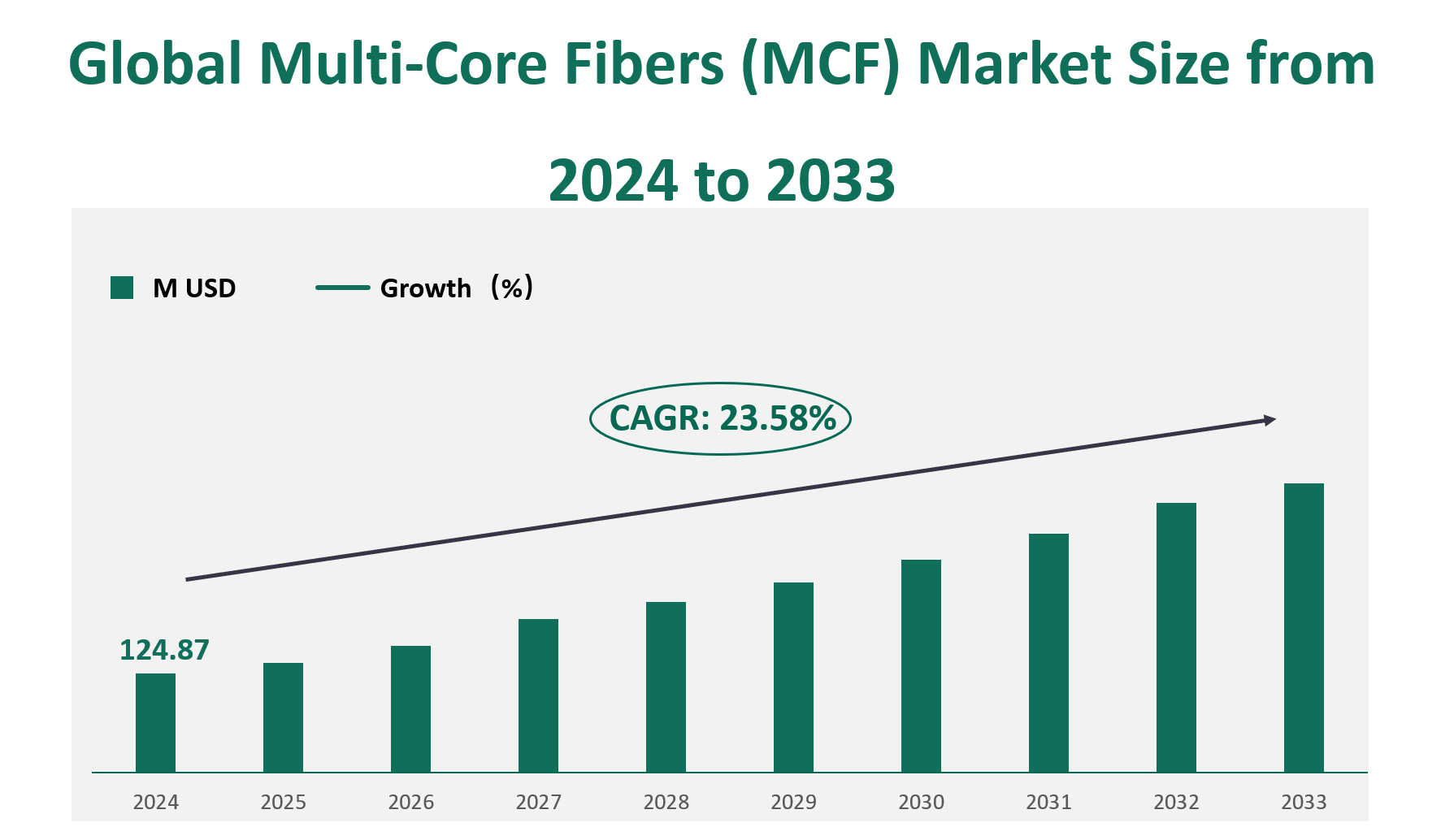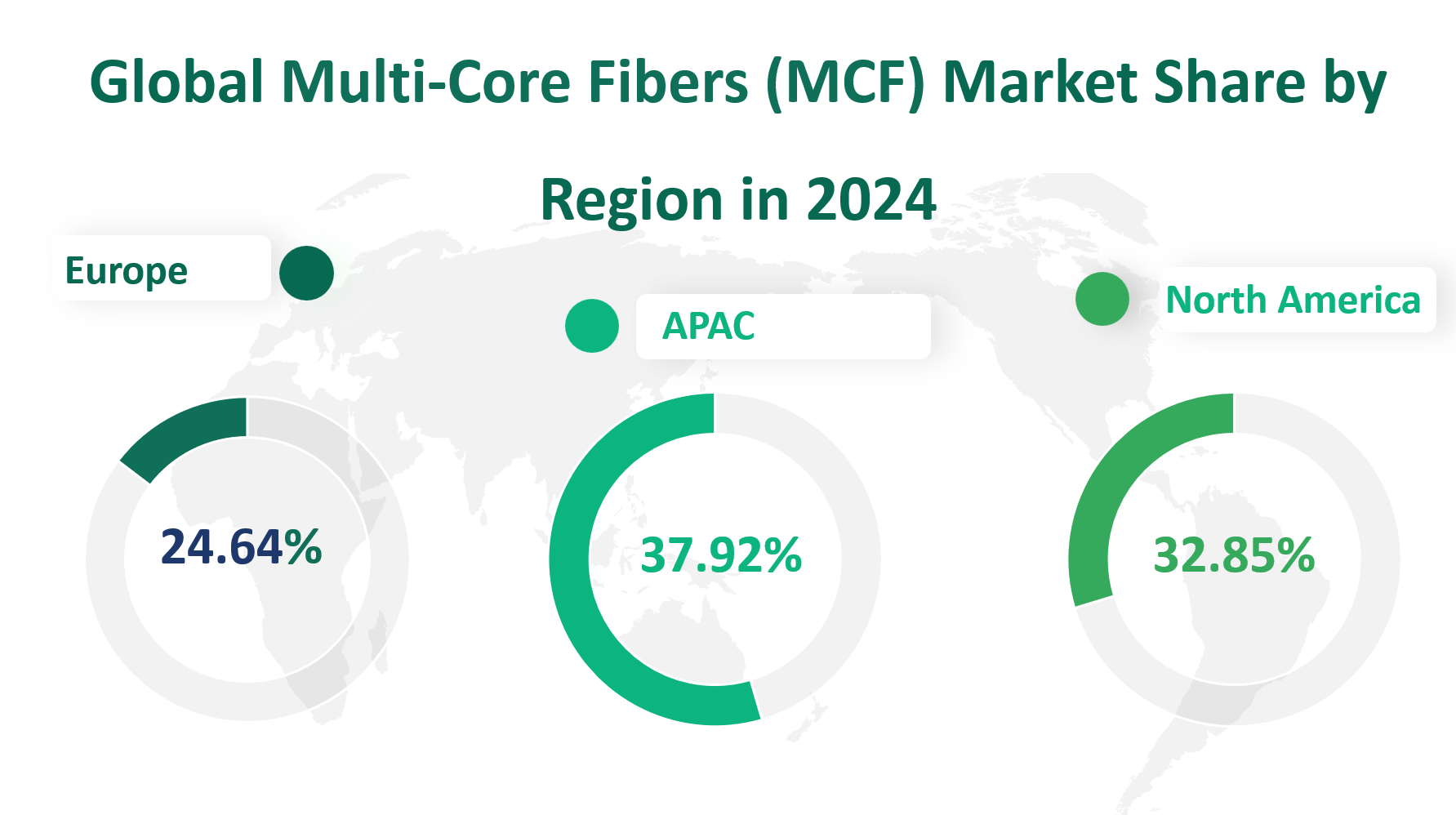1. Global Multi-Core Fibers (MCF) Market Insight Analysis
The global Multi-Core Fibers (MCF) market is experiencing significant growth, with a total revenue of 124.87 million USD in 2024. The Compound Annual Growth Rate (CAGR) for the MCF market is projected to be 23.58% from 2024 to 2033.
Multi-Core Fibers (MCF) represent a revolutionary advancement in optical fiber technology. Unlike traditional single-core fibers, MCFs contain multiple cores within a single cladding. This unique structure allows for greater transmission capacity and spatial density, making MCFs highly efficient for high-capacity data transmission. MCFs are designed to address the limitations of single-core fibers, particularly in terms of bandwidth and crosstalk interference. By incorporating multiple cores, MCFs can significantly enhance the transmission capacity of optical communication systems, making them ideal for applications such as data centers, undersea communication systems, and next-generation fiber amplifiers.
MCFs are particularly advantageous in scenarios where space is limited, as they can replace multiple single-core fibers, thereby optimizing space utilization. For instance, a single 7-core fiber can replace seven individual single-core fibers, thereby improving the spatial efficiency of data centers. Additionally, MCFs can be bundled into ribbon or cluster optical fiber cables, further enhancing their application potential in undersea communication systems. This not only increases transmission capacity but also reduces costs associated with deploying multiple single-core fibers.
Figure Global Multi-Core Fibers (MCF) Market Size (M USD) and CAGR (2024-2033)

2. Driving and Limiting Factors of Multi-Core Fibers (MCF) Market Growth
The growth of the Multi-Core Fibers (MCF) market is driven by several key factors. Firstly, the increasing demand for high-capacity data transmission is a major driver. With the rapid development of multimedia, 5G, and big data services, the need for expanding system capacity and enhancing bandwidth has become imperative. MCFs, with their superior transmission capabilities, are seen as a solution to the current limitations of single-core fibers.
Secondly, the advantages of MCFs over traditional fibers, such as lower production costs, space-saving design, and high transmission capacity, are driving their adoption. MCFs can effectively reduce the amount of fiber required in data centers, thereby improving space utilization and reducing costs. Additionally, the potential for MCFs to be used in various applications, including optical communication, sensing, imaging, and medical equipment, is expanding their market reach.
However, the MCF market also faces several challenges. One of the primary limitations is the issue of inter-core crosstalk. The close proximity of cores in MCFs can lead to signal interference, which can degrade communication quality. While methods such as MIMO technology can mitigate this issue, they require significant computational resources and can be complex to implement.
Another challenge is the lack of uniform standards for MCF design. The absence of standardized specifications for core number, arrangement, size, spacing, and refractive index distribution complicates the fusion splicing of different types of MCFs. This technical bottleneck hinders the widespread application of MCFs and slows down their commercialization process.
3. Technological Innovation in the Multi-Core Fibers (MCF) Market
The Multi-Core Fibers (MCF) market is characterized by significant technological innovation and strategic corporate activities. Companies are continuously investing in R&D to address the challenges associated with MCFs, such as inter-core crosstalk and standardization. For instance, Furukawa Electric Co., Ltd. and KDDI Research, Inc. have developed low-crosstalk MCFs with ultralow attenuation loss, demonstrating advancements in reducing signal interference.
Corporate mergers and acquisitions are also shaping the MCF market. Strategic partnerships and collaborations are becoming increasingly common as companies seek to leverage each other’s strengths to accelerate the development and commercialization of MCF technology. For example, Optoscribe and Sumitomo Electric Industries formed a strategic cooperation to provide MCF components for datacom and telecom applications. Similarly, NEC Corporation, OCC Corporation, and Sumitomo Electric Industries completed the first trial of a multi-core fiber optic submarine cable, showcasing the potential of MCFs in undersea communication systems.
These collaborative efforts not only enhance the technological capabilities of companies but also expand their market reach. By pooling resources and expertise, companies can overcome the challenges associated with MCFs and accelerate their adoption in various applications. As the demand for high-capacity data transmission continues to grow, technological innovation and strategic corporate activities will play a crucial role in driving the MCF market forward.
4. Global Multi-Core Fibers (MCF) Market Size by Type
Four-Core MCFs are optical fibers that contain four separate cores within a single cladding. This design allows for higher data transmission capacity compared to traditional single-core fibers. Four-Core MCFs are particularly useful in applications requiring moderate increases in bandwidth and spatial efficiency.
The Four-Core MCF segment generated a revenue of $18.54 million USD in 2024. This product type is widely used in applications such as data centers and distributed fiber sensors, where moderate increases in transmission capacity are sufficient.
Seven-Core MCFs are optical fibers with seven separate cores within a single cladding. These fibers offer higher transmission capacity and improved spatial density compared to Four-Core MCFs. Seven-Core MCFs are ideal for applications requiring high data throughput and efficient use of space.
The Seven-Core MCF segment had a revenue of $66.98 million USD in 2024. This product type is extensively used in extremely large capacity transmission systems and medical equipment.
Twelve-Core MCFs are advanced optical fibers containing twelve separate cores within a single cladding. These fibers provide the highest transmission capacity among the MCF types and are designed for applications requiring ultra-high data throughput and extreme spatial efficiency. Twelve-Core MCFs are particularly useful in undersea communication systems and next-generation fiber amplifiers.
The Twelve-Core MCF segment generated a revenue of $30.00 million USD in 2024. This product type is used in specialized applications where maximum data transmission capacity is required.
Table Global Multi-Core Fibers (MCF) Market Size by Type in 2024
Market Size (M USD) 2024 | Market Share | |
Four-Core | 18.54 | 14.85% |
Seven-Core | 66.98 | 53.64% |
Twelve-Core | 30.00 | 24.03% |
Others | 9.35 | 7.49% |
5. Global Multi-Core Fibers (MCF) Market Size by Application
Extremely Large Capacity Transmission Systems are advanced communication networks designed to handle vast amounts of data traffic. These systems are essential for applications such as data centers, undersea communication systems, and next-generation fiber amplifiers. MCFs are particularly suited for these applications due to their ability to significantly increase transmission capacity and reduce the physical footprint of fiber installations. The revenue generated by MCFs in Extremely Large Capacity Transmission Systems reached 65.33 million USD in 2024.
Distributed Fibre Sensors are used to monitor physical parameters such as temperature, strain, and pressure over long distances. These sensors are crucial in applications such as structural health monitoring, environmental sensing, and industrial process control. MCFs offer significant advantages in these applications due to their ability to provide multiple sensing channels within a single fiber, enhancing the efficiency and accuracy of sensing systems. The revenue generated by MCFs in Distributed Fibre Sensors reached 31.50 million USD in 2024.
MCFs are increasingly being used in medical equipment, particularly in applications such as endoscopic imaging and optical cell manipulation. These fibers offer high transmission capacity and spatial efficiency, making them ideal for medical imaging and minimally invasive surgical procedures. MCFs can also be used in medical sensors and diagnostic tools, enhancing the accuracy and reliability of medical devices. The revenue generated by MCFs in Medical Equipments reached 21.07 million USD in 2024.
Table Global Multi-Core Fibers (MCF) Market Size by Application in 2024
Application | Market Size (M USD) 2024 | Market Share |
Extremely Large Capacity Transmission System | 65.33 | 52.32% |
Distributed Fibre Sensors | 31.50 | 25.22% |
Medical Equipments | 21.07 | 16.88% |
Others | 6.97 | 5.58% |
6. Global Multi-Core Fibers (MCF) Market Size by Region
Asia Pacific: The Asia Pacific region is the largest market for MCFs by revenue, with a total of 47.35 million USD in 2024. This region’s dominance is attributed to the rapid development of 5G networks, the growth of the consumer electronics industry, and the increasing demand for high-capacity communication fibers.
North America: North America is the second-largest market, contributing 41.02 million USD in 2024. The region’s strong market position is driven by the presence of leading technology companies and advanced infrastructure. The United States, in particular, is a major consumer of MCFs, with significant investments in optical communication systems and data centers.
Europe: Europe’s MCF market revenue reached 30.77 million USD in 2024. The region’s market is driven by the need for advanced communication networks to support the growing digital economy. Countries like Germany, France, and the UK are key markets, with significant investments in R&D and the deployment of MCFs in various applications. Europe’s market is expected to grow steadily, supported by the increasing demand for high-speed internet and the expansion of 5G networks.
Figure Global Multi-Core Fibers (MCF) Market Size by Region in 2024

7. Global Multi-Core Fibers (MCF) Market Analysis by Major Players
7.1 Yangtze Optical Fibre and Cable
Introduction and Business Overview: Yangtze Optical Fibre and Cable is a leading manufacturer of fiber and cable products, with a strong presence in both domestic and international markets. Established in 1988, the company is known for its high-quality communication fibers, specialty fibers, and related products.
Products: Yangtze Optical Fibre and Cable offers a range of MCF products, including seven-core fibers designed for high-capacity data transmission. The company’s MCFs are used in various applications, including data centers and undersea communication systems.
Sales Revenue in 2024: The company’s MCF sales revenue reached $20.29 million USD in 2024.
7.2 Fibercore
Introduction and Business Overview: Fibercore, established in 1982, is a leading developer and manufacturer of single- and multi-mode optical fibers. The company specializes in producing high-quality fibers for telecommunications and data communications applications.
Products: Fibercore offers a variety of MCF products, including four-core and seven-core fibers designed for data cables and shape sensing probes. The company’s MCFs are known for their low crosstalk and high transmission capacity.
Sales Revenue in 2024: Fibercore’s MCF sales revenue reached $17.43 million USD in 2024.
7.3 Fujikura Ltd
Introduction and Business Overview: Fujikura Ltd, established in 1910, is a global leader in the production of wires, cables, and optical fibers. The company is known for its advanced manufacturing capabilities and innovative products.
Products: Fujikura Ltd offers a range of MCF products, including image fibers and multi-core fibers designed for high-capacity transmission systems. The company’s MCFs are used in various applications, including data centers and medical equipment.
Sales Revenue in 2024: Fujikura Ltd’s MCF sales revenue reached $10.33 million USD in 2024.

